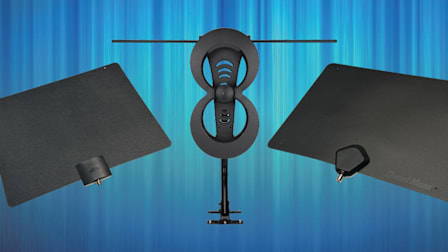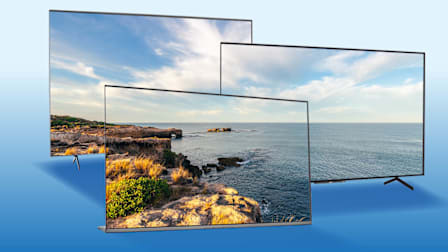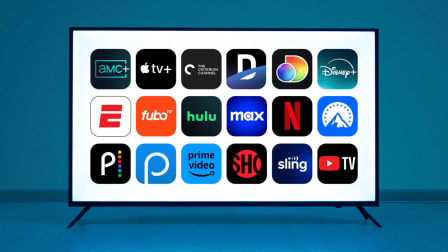Why It Doesn't Always Pay to Buy a Cheap TV
Our analysis of three years of CR's test results shows that models from traditional major brands tend to perform better

It can be hard to resist a bargain when we’re shopping for a TV. But a cheaper TV doesn’t always turn out to be a better deal.
That’s what we found in our analysis of more than three years of Consumer Reports’ TV ratings. Our crack team of statisticians looked at prices and CR’s test results from March 1, 2019, through March 1, 2022, for a number of leading TV brands sold in the U.S. The results are shown in the charts below, broken out by screen size, which is the first factor people usually consider when shopping for a television.
As you can see, TVs from LG, Samsung, and Sony earned top scores in our testing across just about every size range. And generally, sets from these companies cost more than their competitors’ TVs.
70-Inch and Larger TVs
Major brands dominate the top of this slice of our TV ratings, which include 70-, 75-, 77-, 82-, and 85-inch TVs. That list now includes TCL, which has become one of the three top-selling brands in the U.S.
The average price figures we show are a bit higher than the average for all big TVs on the market. That’s both because the largest sets carry a premium and because CR tends to purchase a lot of expensive, high-end sets. That allows us to test the latest features, such as Mini LED backlights in LCD/LED TVs, which can help boost contrast and reduce halos, and high dynamic range (HDR), which can produce brighter, more vibrant images.
We test these flagship models from all the brands, but with major brands there is a much greater difference in pricing between the least and most expensive sets they offer. For example, for TCL there’s a $600 difference between the cheapest ($700) and priciest ($1,300) 75-inch TVs in our current ratings. With Samsung, that difference is dramatic: $1,900. (See the best big-screen TV bargains for sets 70 inches and larger.)
You’ll see that Sony, Samsung, and LG top the list in terms of average Overall Score and average price. Given their high average scores, sets from any of these TV brands might be worth considering. Sony TVs tend to be expensive in part because the company, like LG, now offers OLED TVs, which tend to cost more, but also because it exited the budget TV market. The takeaway for shoppers is that a premium set from Sony might not be more expensive than a premium set from a competitor—the company just doesn’t compete in lower performance tiers.
TCL, Vizio, and Hisense are additional brands to consider, especially if you’re on a budget. With TCL and Hisense, higher-end sets (the 6- and 8-series TVs from TCL, and 8-series sets from Hisense) have done very well in our tests, offering a lot of bang for the buck in terms of both picture quality and high dynamic range (HDR) experience. TCL’s higher average price is due to its top-tier sets having newer technologies (Mini LED, 8K resolution), plus a push into very large screen sizes. The company also offers many low-priced sets that haven’t done as well, lowering the brand’s Overall Score. Vizio sets have done well for overall picture quality across the board, though they generally fall behind a bit when it comes to HDR.
RCA sets haven’t fared well in our ratings, but their average price is markedly lower than any other brand’s, especially in this screen size.
65-Inch TVs
This has become a popular screen size for people looking for a large TV. And you’ll see that LG, Samsung, and Sony top the list in average Overall Score and average price here, as well. One reason for the fine showing by both LG and Sony is they offer OLED TVs that have consistently been at the top of our ratings. Samsung’s top QLED (and Neo QLED) TVs have also done very well in our ratings, and the best of those sets now rival OLED TVs in performance. All these sets tend to be pricy.
In this size category, we again see much greater differences in pricing between the least and most expensive sets from major brands than from smaller players. For example, there’s a $600 difference between the cheapest ($400) and priciest ($1,000) 65-inch Hisense TVs in our current ratings. With Samsung and Sony, that difference is a whopping $2,400. One reason for Samsung’s large spread is the debut of its first QD OLED TV ($3,000), which is now in our ratings (though it arrived too late this year for our statistical analysis). Sony TVs tend to be expensive in part because the company offers several OLED TVs, which tend to cost more, and because it stopped making lower-end LED/LCD sets. (See the best 65-inch TVs under $1,000.)
As in the 70-inch size category, Hisense, TCL, and Vizio appear to be good options for those on tighter budgets. Their better-performing sets tend to be pricier but still less expensive than comparable TVs from LG, Samsung, and Sony. Hisense has the best balance of price and performance of the group. But given the wide differences in performance and price between the best- and worst-performing models within these brands, you should look at specific models to determine the best value.
55- to 60-Inch TVs
If you’re shopping for a 55- to 60-inch set, you’ll see a particularly wide range of prices and brands. That’s because some TVs this size are relatively bare-bones when it comes to features, while others come loaded with lots of features. These can include 120Hz refresh rates, full-array LED backlights with local dimming, more effective HDR performance, and special gaming features, such as low-latency modes and variable refresh rates.
Average prices go from a low of $342 (for Toshiba, which makes Fire TV Edition sets sold at Amazon and Best Buy) to a high of $1,034 (Sony’s average). As we note above, Sony focuses on higher-priced sets, and both Sony and LG’s average prices are pulled up by their OLED sets—these TVs can look great, but they tend to cost more than all but the very best LED/LCD models.
Two years ago, Vizio began offering OLED TVs, but that hasn’t yet had a big impact on its average price, because the majority of its sales are still less expensive LED/LCD TVs.
In term of Overall Score, there’s a bit of drop-off after LG. Some models from Hisense, Insignia (Best Buy’s house brand), TCL, Toshiba, and Vizio might be worth considering for less finicky viewers who are on an even tighter budget. As we mentioned earlier, some higher-end Hisense and TCL sets deliver very satisfying overall picture quality and enjoyable HDR. Many sets from the other brands do well for overall picture quality, but the trade-off is a less satisfying HDR experience. Insignia seems to be a decent choice for budget-minded consumers, earning a higher average Overall Score than Toshiba despite having a lower average price.
46- to 52-Inch TVs
For those shopping for a TV in this size range, CR’s analysis shows that Samsung, Sony, and LG again tend to have the highest-performing TVs—along with the most expensive ones.
Of these three brands, LG sets seem particularly attractive, with a high Overall Score and an average price below these two other brands’ average prices. In last year’s analysis, however, LG’s average price was much closer to the lower-tier brands’. This could be in part because of LG offering 48-inch OLED TVs. This year, there’s a bigger price spread between the major and secondary brands. That could be because major brands tend to adopt the newest technologies first.
In fact, the price range is fairly narrow in this size category once you get past those top three brands. Hisense and TCL emerge as good possible options for those on the tightest TV budgets because their average price is actually lower than a few brands’, such as Vizio and Toshiba, that have lower average scores.
39- to 43-Inch TVs
There’s also a pretty big spread in both price and performance in this screen size, with prices ranging from $226 (Hisense) to more than $568 (Sony). One reason is that in this size category, you’ll find a mix of both 4K and more basic HD sets.
There aren’t a lot of surprises—Sony, Samsung, and LG offer the best performance. The least expensive of these brands is LG, but Insignia also emerges as an especially attractive option, given its average price and an Overall Score just a point away from LG’s. In Insignia’s case, the average price is actually below several brands’ that have lower Overall Scores.
Remember, though, that the price and performance averages are for entire brands, not specific models. The best way to see how individual TV models perform is to check our ratings, which are based on extensive testing and evaluation.
32-Inch TVs
These days, 32-inch TVs have largely been commoditized; most are either 720p or 1080p regular high-definition TVs rather than 4K models, and there are even some low-priced basic models that lack a smart TV feature.
You may notice that Samsung is missing from this size category; there weren’t enough tested models in our analysis this year for it to be included. It’s the only brand in our current ratings that offers 32-inch 4K TVs with HDR, but those sets are more expensive, and consumers don’t seem to want to pay for the higher resolution in sets this small. Samsung does offer a number of less expensive HD sets, which are in our ratings. Shoppers seem to buying based on price rather than brand.
As you can see in the chart, with Samsung absent, along with Sony, LG becomes the clear top brand based on performance, and its average price isn’t all that much higher than prices on other brands.
Apart from LG, there’s not much of a difference among the other brands in either average price or performance, but Hisense has the lowest overall average price, while Vizio has the highest.
With both price and performance averages so closely packed among the brands, smart shoppers are likely to look to other criteria in our TV ratings, such as screen resolution, sound quality, or reliability, or features such as built-in access to streaming content, to help make a buying decision.
Beyond the Scores: Repairs and Reliability
In addition to TV performance, there are a few more things to consider when choosing among brands. One is how easy it is to get the TV repaired in a timely manner. Major brands typically invest in parts and service networks, so you’re more likely to find an authorized repair center nearby.
Reliability problems appear to be less of an issue, based on our surveys, because TVs are among the more reliable products Consumer Reports analyzes. But not all brands do as well as others, which is why you should check a brand’s reliability in our TV ratings.
Because most sets are now smart TVs that connect to the internet, we’ve added privacy and security scores to our ratings. We evaluate the various ways TV brands collect, use, and share consumer data; how well they protect it; and how transparent they are about their data practices.
Last, consider the manufacturer’s warranty, which could be shorter with an off-brand TV. Most of the TVs in our ratings carry 1-year parts and labor warranties, but that can vary, so check before you buy.
@consumerreports An inexpensive TV is no bargain if the picture quality disappoints you. See ratings and reviews at cr.org/tv #techtok #tv #shoppingtips #tvtech
♬ original sound - Consumer Reports






























